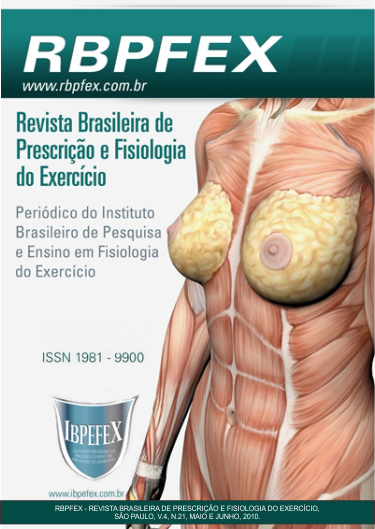Flexibility In Water Aerobics
Abstract
This study has the purpose to analyzethe importance of wateraerobics in the improvement of flexibility of people who practice this physical activity. 16 (sixteen) women who have taken part in the group of water aerobics since 2009 at Fisiofoz Clinicin Foz do Iguaçu, at ages ranging between 28 and 68, participated in the research. The cohort underwent a flexibility test which includes the bench Wells: a test of sitting and reaching. Two measures were taken: a pre-test and a post-test (one before the beginning of the research and the other after 102 days). After the first test, the women took the water aerobics exercises three times a week and after 3 (three) months and 14 (fourteen) days, the test was applied again and the results obtained demonstrate that the participants had progressive outcome during the experimental phase of the activity. The data have drawn the conclusion that water aerobics contributes strongly to the acquirement or maintenancesof flexibility. Essentialfor people’squality of life.
References
-Achour Júnior, A –Bases para exercícios de alongamento relacionado com a saúde e o desempenho atlético. 2ª edição. Londrina: Phorte editora, 1999.
-Achour Júnior, A. Exercícios de alongamento: anatomia e fisiologia. São Paulo: Manole, 2002.
-ACSM -American College Of Sports Medicine. Diretrizes do ACMS para os Testes de Esforço e sua Prescrição. 6. ed. Rio de Janeiro: Guanabara, 2003. 239.
-Capitanio, A.M. Educação através da pratica esportiva: Missão impossível? Revista Digital. Ano 8. Num. 58. 2003.
-Dantas, E.H.M. A prática da preparação física. 5.ed. Rio de Janeiro: Shape, 2003.463p.
-Dantas, E.H.M. Flexibilidade: alongamento e flexionamento. 4ª edição. Rio de Janeiro: Shape, 1999.
-Guedes, D.P.; Guedes, J.E.R.P. Prescrição e orientação da atividade física direcionada à promoção de saúde. Londrina: Miograff, 1995.
-Hamil, J.; Knutzen, K.M. Bases biomecânicas do movimento humano. São Paulo: Manole, 1999.
-Hollmann, W.; Hettinger, Th., “Medicina do Esporte”. Editora Manole Ltda, São Paulo, Publicações INDESP, Brasília, 1999.
-Matsudo, S.M.M. Envelhecimento & atividade física. Londrina: MIDIOGRAF, 2001.
-Matsudo, S.M.M. Avaliação do Idoso: fisica & Funcional. Londrina: MIDIOGRAF. 2004.
-Otto,E. Exercícios físicos para a terceira idade. São Paulo. Manole, 1987.
-Phillips, W.T.; Haskell, W."Muscular fitness" Easing the burden of disability for elderly adults. Journal of again and physical activity. Vol. 3. 1995. p. 261-289.
-Pollock, M.; Wilmore J. H. Exercícios na saúde e na doença: avaliação e prescrição para prevenção e reabilitação. 2. ed. Rio de Janeiro : MEDSI, 1993.
-Rider, R.A.; e colaboradores. Effects of flexibility training on enhancing spinhal mobility in older women. Journal Sports Medicine and Physical Fitness. Vol. 31.Num. 2. 1991. p. 213-217.
-Robergs, R.A.; Roberts, S.O. Princípios fundamentais de fisiologia do exercício para a aptidão, desempenho e saúde. 1ª edição. São Paulo: Phorte editora, 2002.
-Soares, J.S.; Ota, A.H.; Dantas, E.H.M. Hidroflexibilidade. Fitness & Performance Journal. Rio de Janeiro: COBRASE. v. 1. N.5.
-Thomas, R.J.; Nelson, J.K. Métodos de pesquisa em atividade física. 3. ed. Porto Alegre: Artmed, 2002. 419p.
-Velert, C.P.;Devis, J.D. Una propuesta escolar de educación física y salud. In: Devis, J.D. & Velert, C.P. 1 ed. nuevas perspectivas curricularesen educación física: la salud y los juegos modificados. Barcelona: INDE publicaciones, 1992.
-Weineck, J. Atividade física e esporte para quê? São Paulo: Manole, 2003.
Authors who publish in this journal agree to the following terms:
- Authors retain the copyright and grant the journal the right of first publication, with work simultaneously licensed under the Creative Commons Attribution License BY-NC which allows the sharing of the work with acknowledgment of the authorship of the work and initial publication in this journal.
- Authors are authorized to enter into additional contracts separately for non-exclusive distribution of the version of the work published in this journal (eg, publishing in institutional repository or book chapter), with acknowledgment of authorship and initial publication in this journal.
- Authors are allowed and encouraged to post and distribute their work online (eg, in institutional repositories or on their personal page) at any point before or during the editorial process, as this can bring about productive change as well as increase impact and impact. citation of published work (See The Effect of Free Access).






